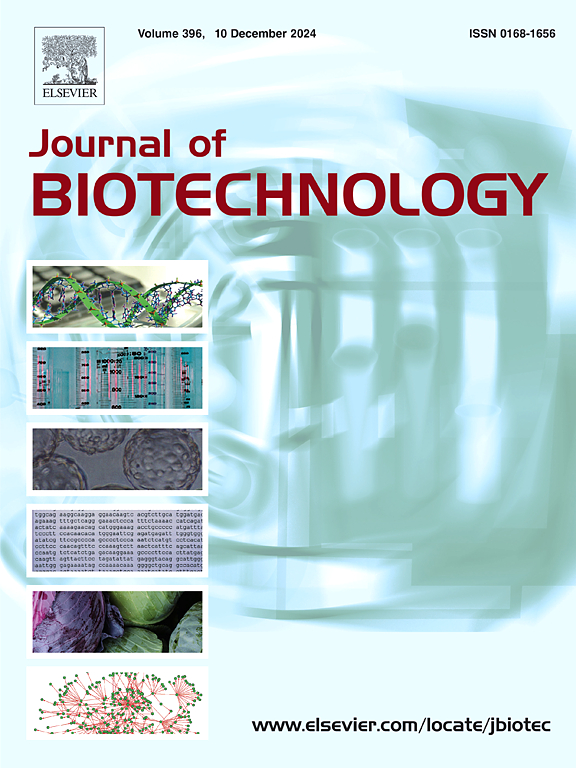Fungal elicitors increase cell biomass, pyrroloquinazoline alkaloids production and gene expression levels of biosynthetic pathways in Adhatoda vasica Nees cell cultures
IF 4.1
2区 生物学
Q2 BIOTECHNOLOGY & APPLIED MICROBIOLOGY
引用次数: 0
Abstract
Adhatoda vasica Nees (Fam. - Acanthaceae) is used in the treatment of cold, cough, chronic bronchitis, and asthma. The plant species contain vasicine, vasicinone, 2-acetyl benzyl amine, adhatodine, vasicinolone, deoxyvasicinone, and vasicine acetate. To examine the effects of fungal elicitors on the production of pyrroloquinazoline alkaloids, five fungal elicitors (Alternaria alternata, Rhizoctonia solani, Colletotrichum gloeosporioides, Colletotrichum capsica, and Puccinia thwaitesii) were used. Four concentrations (2.5, 5.0, 10, and 20 %) of 5 fungal elicitors were added in the MS culture medium. The concentrations were designed to observe their effects (minimal to maximal) on growth and production of alkaloids in cell cultures. The seedlings of this species were transferred onto Murashige and Skoog medium containing IAA (1.5 mg/L) and BA (1.0 mg/L). The maximum quantity of vasicine (1.25 ± 0.023 %; p < 0.001) was recorded in 6 weeks old callus. The quantity of vasicine was lower in callus (1.25 ± 0.023 %; p < 0.001) than aerial parts (6.64 ± 0.034 %; p < 0.01) and roots (5.97 ± 0.097 %; p < 0.01). Alternaria alternata (10 %) increased the growth of cell biomass as well as anthranilate synthase and anthranilate N-methyl transferase activities. Similarly, Alternaria alternata showed maximum increase in the production of vasicine whereas other elicitors displayed moderate increase in alkaloid production. The expression quantities of 10 genes, involved in pyrroloquinazoline alkaloids biosynthesis, were determined in this study. The maximum expression level (11.38-fold) of anthranilate synthase was observed in elicited cells treated with A. alternata. The study results suggest widespread use of fungal elicitors in increasing the production of secondary metabolites as well as gene expression levels in plant cell cultures.
真菌激发子增加了水蛭细胞培养中细胞生物量、吡咯喹啉类生物碱的产量和生物合成途径的基因表达水平
水芹(Adhatoda vasica Nees);-棘科)用于治疗感冒,咳嗽,慢性支气管炎和哮喘。该植物种类含有水杨碱、水杨碱酮、2-乙酰苄基胺、adhatodine、水杨碱诺酮、脱氧水杨碱酮和水杨碱醋酸酯。为了研究真菌激发子对吡罗喹唑啉生物碱生产的影响,采用了5种真菌激发子(alternnaria alternata, Rhizoctonia solani, Colletotrichum gloeosporioides, Colletotrichum capsicica和Puccinia thwaitesii)。在MS培养基中分别添加4种浓度(2.5、5.0、10、20 %)的5种真菌激发子。这些浓度的设计是为了观察它们对细胞培养中生物碱的生长和产生的影响(从最小到最大)。将该种苗转移到含IAA(1.5 mg/L)和BA(1.0 mg/L)的Murashige和Skoog培养基上。vasicine的最大用量(1.25 ± 0.023 %;P <; 0.001)。愈伤组织中vasicine的含量较低(1.25 ± 0.023 %;P <; 0.001)高于航空部件(6.64 ± 0.034 %;P <; 0.01)和根(5.97 ± 0.097 %;p & lt; 0.01)。互交菌(10 %)提高了细胞生物量的生长,提高了细胞内邻氨基甲酸酯合成酶和邻氨基甲酸酯n -甲基转移酶的活性。同样地,互花莲子在产生水蛭素方面表现出最大的增加,而其他激发子在产生生物碱方面表现出适度的增加。本研究测定了10个与吡咯喹啉类生物碱生物合成有关的基因的表达量。结果表明,在草霉诱导的细胞中,邻氨基甲酸酯合成酶的表达量最高,为11.38倍。研究结果表明,真菌激发子在植物细胞培养中广泛使用,以增加次生代谢物的产生和基因表达水平。
本文章由计算机程序翻译,如有差异,请以英文原文为准。
求助全文
约1分钟内获得全文
求助全文
来源期刊

Journal of biotechnology
工程技术-生物工程与应用微生物
CiteScore
8.90
自引率
2.40%
发文量
190
审稿时长
45 days
期刊介绍:
The Journal of Biotechnology has an open access mirror journal, the Journal of Biotechnology: X, sharing the same aims and scope, editorial team, submission system and rigorous peer review.
The Journal provides a medium for the rapid publication of both full-length articles and short communications on novel and innovative aspects of biotechnology. The Journal will accept papers ranging from genetic or molecular biological positions to those covering biochemical, chemical or bioprocess engineering aspects as well as computer application of new software concepts, provided that in each case the material is directly relevant to biotechnological systems. Papers presenting information of a multidisciplinary nature that would not be suitable for publication in a journal devoted to a single discipline, are particularly welcome.
 求助内容:
求助内容: 应助结果提醒方式:
应助结果提醒方式:


